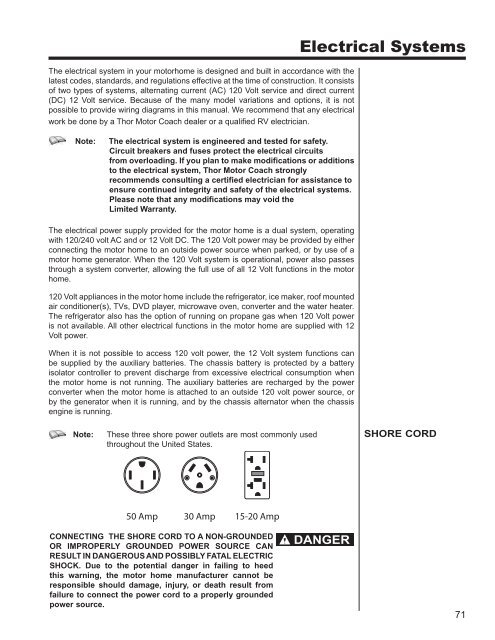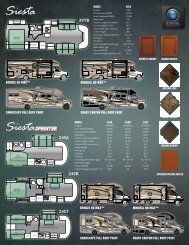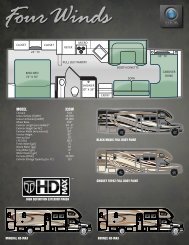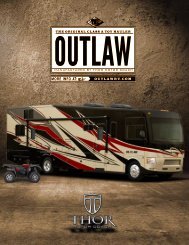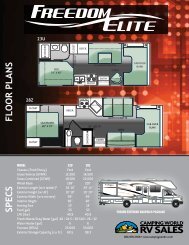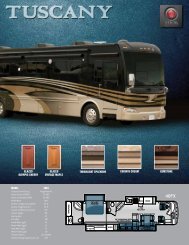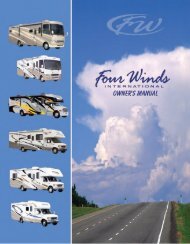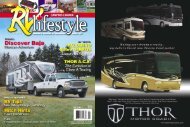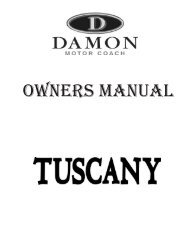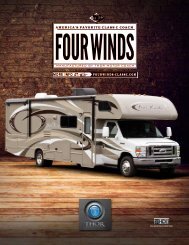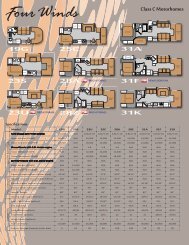caution - Thor Motor Coach
caution - Thor Motor Coach
caution - Thor Motor Coach
Create successful ePaper yourself
Turn your PDF publications into a flip-book with our unique Google optimized e-Paper software.
The electrical system in your motorhome is designed and built in accordance with the<br />
latest codes, standards, and regulations effective at the time of construction. It consists<br />
of two types of systems, alternating current (AC) 120 Volt service and direct current<br />
(DC) 12 Volt service. Because of the many model variations and options, it is not<br />
possible to provide wiring diagrams in this manual. We recommend that any electrical<br />
work be done by a <strong>Thor</strong> <strong>Motor</strong> <strong>Coach</strong> dealer or a qualified RV electrician.<br />
Note: The electrical system is engineered and tested for safety.<br />
Circuit breakers and fuses protect the electrical circuits<br />
from overloading. If you plan to make modifications or additions<br />
to the electrical system, <strong>Thor</strong> <strong>Motor</strong> <strong>Coach</strong> strongly<br />
recommends consulting a certified electrician for assistance to<br />
ensure continued integrity and safety of the electrical systems.<br />
Please note that any modifications may void the<br />
Limited Warranty.<br />
The electrical power supply provided for the motor home is a dual system, operating<br />
with 120/240 volt AC and or 12 Volt DC. The 120 Volt power may be provided by either<br />
connecting the motor home to an outside power source when parked, or by use of a<br />
motor home generator. When the 120 Volt system is operational, power also passes<br />
through a system converter, allowing the full use of all 12 Volt functions in the motor<br />
home.<br />
120 Volt appliances in the motor home include the refrigerator, ice maker, roof mounted<br />
air conditioner(s), TVs, DVD player, microwave oven, converter and the water heater.<br />
The refrigerator also has the option of running on propane gas when 120 Volt power<br />
is not available. All other electrical functions in the motor home are supplied with 12<br />
Volt power.<br />
When it is not possible to access 120 volt power, the 12 Volt system functions can<br />
be supplied by the auxiliary batteries. The chassis battery is protected by a battery<br />
isolator controller to prevent discharge from excessive electrical consumption when<br />
the motor home is not running. The auxiliary batteries are recharged by the power<br />
converter when the motor home is attached to an outside 120 volt power source, or<br />
by the generator when it is running, and by the chassis alternator when the chassis<br />
engine is running.<br />
Note: These three shore power outlets are most commonly used<br />
throughout the United States.<br />
CONNECTING THE SHORE CORD TO A NON-GROUNDED<br />
OR IMPROPERLY GROUNDED POWER SOURCE CAN<br />
RESULT IN DANGEROUS AND POSSIBLY FATAL ELECTRIC<br />
SHOCK. Due to the potential danger in failing to heed<br />
this warning, the motor home manufacturer cannot be<br />
responsible should damage, injury, or death result from<br />
failure to connect the power cord to a properly grounded<br />
power source.<br />
Electrical Systems<br />
SHORE CORD<br />
71


